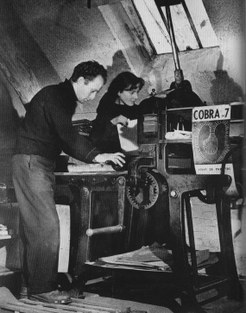© COBRA: Photography, Film and Prints
- This page is part of our exhibition archive. The exhibition took place from 29-11-2019 to 15-02-2019
The Danish-Belgian-Dutch art movement Cobra (1948-1951) is first and foremost associated with expressive and colorful paintings. Lesser known are the many experiments with print, photography, and film.
Copyright COBRA focuses on this understudied relation between Cobra and techniques of mechanical reproduction in Belgium and pays attention to the studios of Les Ateliers du Marais, which was founded in 1949 in Brussels and where artists and theorists such as Alechinsky, Dotremont, Vandercam, Ubac, Raine, and de Heusch came into contact with modern media. The litho press in the attic created an artistic mark on various editions and publications, such as the Cobra magazine in which the movement spread their ideas. Particularly the Belgian issues show an explicit fascination for photography, film, and printed matter. This interest also resulted in works combining words and images such as Dotremont’s Dessin-mots and his later Logograms as well as Alechinsky’s documentary film Calligraphie Japonaise (1956). Belgium was also the site of Cobra’s sole photography exhibition, Les Développements de l’Oeil (1950), and of the only Cobra film: Perséphone (1951) by de Heusch, which was inspired by Alechinsky’s photobook Poupées de Dixmude (1950). Copyright COBRA aims to contribute to a better understanding of the significance of graphical and mechanical reproductions for the Belgian artists of the Cobra movement.
Curators: Griet Bonne (Ghent University), Joséphine Vandekerckhove (Ghent University), and Marit Van der Jeugt.
With the collaboration of Camille Bladt, Tatiana Crombeen, Basile Dekeyser, Laura Persijn and Esther Van den Abeele (students MA in Art History, Ghent University), Anton Pereira Rodriguez (Ghent University).
Scientific committee: Steven Jacobs (Ghent University) and Karen Kurczynski (University of Massachusetts)
